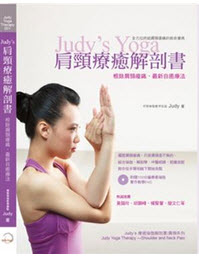又来了,各位同学,令各位又爱又恨的瑜伽医学原文讲义,再度出现在各位的眼前.
不要闪躲,不要害怕,英文并不可怕,可怕的是,根本不看,其实,有看有保佑,难保那一天,阁下您突然大发愿心,想要出国提升自己的专业知识,那么考取国际瑜伽联盟(Yoga Alliance)认证必然会成为您的人生目标,其中anatomy(人体解剖学)就是必考项目之一,与其在国外看阿豆那表演,还不如在国内先打好基础,您说是吧!各位爷们!
为了让每两个月的瑜伽医学研讨会,料好实在!才疏学浅的Judy,只好为各位同学上穷碧落下黄泉,搜集许多的专业文章,别小看这本小小的讲义,里面有深度的国外文章,基本的解剖生理学知识,还有从复健及运动医学切入的专业文章,集结成册,配合专业的研讨会发给各位,就是希望大家的瑜伽医学功力能提升.
啊!今天有同学向我反应,讲义太难了,我后来才想到,她那天最晚才到,她很不错,刚下完课,包了台小黄,直奔梵瑜伽,但可惜的是,错过了先前的基础医学的讨论,难怪会觉得讲义有点难,其实,不瞒你说,专业的文章真的粉难懂,所以才要开研讨会,透过Judy本人的搞笑演出,包证让你心领神会,为了传逹忠实的知识,上课前还先找医学博士赖庭玮医师,帮我指导一番,否则,好的老师带你上天堂,坏的老师,带你下地狱,这可不是闹著玩,我是个粉严谨的人滴!
今天总算将上期的膝盖研讨会的讲义寄给对岸的网友苹果,对我而言,瑜伽医学知识的传播是很重要的,瑜伽,有太多的流派,每种流派有它不同的教义及规定,因此您必须多尝试,才能找出适合自己的瑜伽.这让我不禁想起space专授Mysore老师Gladys,她说:千言万语,不如一个体会.
看过金庸笔下的神雕侠侣,就知道古墓派的小龙女,轻功了得,内力更是浑厚,不显于外.若说,Gladys是小龙女再世,真是再适合也不过了.温柔婉约的她,十分有耐心,常常提醒我,要用呼吸带领动作.
”不急,瑜伽,就像是一朵花,常练,它就开花了”还记得上几篇我提到的经典名言吧,就是出自于她的体会.
Paul Dallaghan,是ashtanga派系祖师嫡传弟子,也是许多人敬仰的偶象,他的体会是什么呢!他说,
”最伟大的老师,便是练习本身”
只有练习,才能体会,一个体会,胜过长篇大论.
想要体会瑜伽欲死欲仙的奥妙,就来问问练ashtanga的人,尤其是有上过Mysore的人,特别能体会,那种练到全身快虚脱,汗水直流,快要撑不下去却又不断跨越自己极限的快感,只有一句话可以形容,置死地而后生,劫后余生的快乐,当然是笔墨难以形容.当然,想要让自己更精进,必须要先克服惰性.这也就是我写持戒的由来.
但突破自我极限,是一个迷思,很吊诡!!也很迷人.
每个人,生来就与众不同,有人先天骨子软,有人骨头硬梆梆,有人不用暖身直接就劈腿,你当他厉害,我为他担心,有人可以后弯到手抓脚跟,在众人喝采下,我却担心她脊椎关节不稳定,一体总是两面,柔软度好,意谓著稳定性差,所以,瑜伽,没有所谓的标准动作,符合你的生理状况,尽心去做,就可以了,不是每个人都可以成为David Sweson,也不是每个人都可以逹到脚放头顶的瑜伽招牌动作.
为什么,因为你不是他,他也不是你,先天基因,后天环境,以及个人状况等诸多因素使然,我们必须相信,人是有差异性,也因为如此,每个人才会如此独特,世界才会如此美好,瑜伽才会如此多元化,记得,老子曾说过一句话,完美的东西,是不存在的,存在的东西,基本上是不完美的,不完美的东西,真的是不完美吗!错了,有缺陷的美,才是真的完美.
你懂了吗,老子真是老子,道可道,非常道,但他还是在出关逃难前,在牛背上,勉为其难地说了出来.
你找到你的瑜伽了没,不要流于瑜伽名牌化的迷思中,听听你身体的声音,它会告诉你答案,只要你愿意停下心来,聆听.
对了,10月份的瑜伽医学研讨会改时间,感谢林正雄老师的大力支撑,将初级班的时间延后,以利我们办活动,也让周六远从外地来研习班的同学有机会参加,所以,在各方配合下,我们又可以在可爱的星期六办我们最爱的研讨会,大家要报名的话,请在布落格留言,梵瑜伽的妺妹,会帮各位登记下来,人数一样限制在40人之内,人太多,教学品质会下降,这不是我想要,所以,各位,要报名要快哟!!膝关节的演讲讲义,我这个礼拜会弄出来,先前MP3有点问题,送修,真不意思,让各位等太久了.
主题:瑜伽与脊椎侧弯
时间:10/21(日)11:00~14:00
地点:梵瑜伽02-82534335
主讲:简文仁理事长(中华民国物理治疗全国联合会理事长)
费用:500元(含讲义,我做的讲义绝对精彩)
终于决定改成十月的第三个星期六,
11:00~12:00脊椎解剖学课,(教室)
12:00~13:30理事长主讲(教室)
13:30~14:00会后讨论(在柜台区讨论,不妨碍初级班一点半的课程)
有空大家要记得参加啊,我有买人体模型哟,说不定那天会带去,如果不会吓到路人的话.谁有空,将下面的英文翻一下吧.不要偷笑,就是你啦,对,就是每天都会上来晃一下的~~~~~~~~~~~~你 .
.
Yoga for Scoliosis
With regular practice, you can ease the pain of a crooked back and turn it into a powerful teacher.
By Elise Browning Miller
The dull aching on the right side of my mid-back was familiar. Sitting at my desk all day working on income taxes was not only dulling my mind, it was creating a pain in my body that I could no longer ignore. So I got up and headed for the kitchen. Stuffing my face was always a quick solution for the pains and problems of life.
As I grabbed for the food, it occurred to me, "Not only am I in pain, I’m downright depressed! "Though I knew taxes were not always an enlightening task, I hadn’t realized that my whole psyche was besieged by negativity. Was my negative attitude affecting my already vulnerable back or was it the other way around? Either way, eating was not going to solve the problem.
I knew of only one solution for my spasmed back and negative attitude. For years, only yoga had helped me cope with the pain I had lived with almost all my life. At 16 months, I had fallen down a steep flight of basement stairs. Initially, the family physician thought I had only broken my nose. Years later, I found out that my ribs had been knocked out of position from the accident, which gradually created a lateral curvature of the spine called a scoliosis.
What is Scoliosis?
Perhaps the most dramatic of spinal aberrations, scoliosis appears in cave paintings of prehistoric man and was first treated with braces by the Creek physician Hippocrates in the fourth century B.C, Not only does it create spinal deformity and rib displacement, it twists the shoulders and hips and shifts the body’s center of gravity. Its most obvious symptoms are cosmetic, but pain and cardiopulmonary complications (due to compression of the heart and lungs) are also common. The word "scoliosis" is derived from the Greek word skol, which means twists and turns. In scoliosis, the spine forms an S curve (or reversed S) from side to side down the back, and at the same time the back of the spine rotates toward the concave side of the S, twisting the rib cage and making the sides of the back uneven. (To observe this effect, bend a hose into an S shape and observe how it rotates at the same time.) Particularly when this curvature occurs in the mid-back region, the ribs compress on the concave side of the spine and spread apart on the convex side. On the concave side, the attached ribs are pushed sideways and forward, while on the convex side, they collapse toward the spine and move back, thus forming the characteristic rotation of the rib cage. The ribs on the convex side often protrude posteriorly, and over this protrusion there frequently develops a tense, painful mass of muscle tissue.
Four Major Scoliosis Curves
Curvature can take place anywhere in the spinal column but generally follows four common patterns. In a right thoracic scoliosis, the major scoliosis is concentrated in the thoracic (mid-back) region, and the spine curves to the right. (There may also be a counter curve to the left in the lumbar region, but this curve is less severe.) In a left lumbar scoliosis, the major curve is to the left and is concentrated in the lumbar (lower back) region, though, as shown in the diagram, there may be a less extreme counter curve to the right in the thoracic region. A third type of scoliosis is the right thoraco-lumbar, where the major curve is to the right in the thoracic and lumbar region. The last type of curvature is the right thoracic-left lumbar combined curve, where the major curve is to the right in the thoracic region, with an equal counter curve to the left in the lumbar region. For unknown reasons, 90 percent of thoracic and double curves are right convexity (curve to the right); 80 percent of the thoraco-lumbar curves also are right convexity; and 70 percent of the lumbar curves are left convexity. Seven times as many women as men have scoliosis.
Structural and Functional Scoliosis
Scoliosis can be either structural or functional. The structural variety is much more serious and develops as a result of unequal growth of the two sides of the vertebral bodies. It usually appears during adolescence, and its causes are not well understood–approximately 70 percent of all structural scoliosis are idiopathic, meaning doctors do not know why they develop. Functional scoliosis only affects the back muscles and does not structurally alter the body. It can result from such things as poor posture or repeated unbalanced activity, such as always carrying books on one side. It is much more common than structural scoliosis, usually much less noticeable since the degree of curvature is less, and almost always reversible.
To determine whether a scoliosis is functional or structural, bend forward from the hips. If a lateral (side to side) curve visible in standing disappears in this position, the scoliosis is functional; if the curve remains, it is built into the ribs and spine, and the scoliosis is structural.
Yoga or Surgery?
When I was 15, my family physician informed me that I had a severe structural right thoracic scoliosis. He recommended a brace and threatened me with a possible fusion of the spine, an operation in which metal rods are inserted next to the spinal column to prevent the curvature from growing worse. Appalled, I consulted a top orthopedic surgeon, who suggested that instead I try a regimen of exercise and stretching.
I exercised regularly throughout high school and college, but although 1 experienced little discomfort, I noticed that my posture was becoming worse. I was rounding my shoulders, particularly on the right side; and when I wore a bathing suit, I noticed that the right side of my back protruded more than the left. After graduation, while working with the Peace Corps in Brazil, I began to experience spasms and acute pain in my back. Guided by a fellow Peace Corps volunteer, I turned to hatha yoga.
When I stretched in the yoga poses, the numbness on the right side of my, back went away, and the pain started to dissolve. To explore this path further, I returned to the United States, where I studied at the Integral Yoga Institute with Swami Satchidananda and learned about the importance of love, service, and balance in life and yoga practice. Then I turned to the Iyengar system to explore in depth the way the therapeutic use of yoga postures could help my scoliosis.
Since that time, I have been exploring and healing my body through the practice of yoga. By teaching students with scoliosis, I have learned how to assist others with their own explorations. I have found that although every scoliosis is different, there are certain philosophical guidelines and practical yoga postures that can be helpful to yoga students with scoliosis.
To determine whether a scoliosis is functional or structural, bend forward from the hips. If a lateral (side to side) curve visible in standing disappears in this position, the scoliosis is functional; if the curve remains, it is built into the ribs and spine, and the scoliosis is structural.
1. Feet and Iegs. When standing and walking, it is very important to place equal weight on both feet and to be aware of any imbalances. Strengthening the legs creates a solid foundation from which the spine can stretch and become freer, and it enables the legs, rather than the spine, to carry the weight of the body.
2. Spine. Since this is where the scoliosis is located, it is important to focus on lengthening the spine, which tends to reduce the S curve.
3. Psoas (Major and Minor). These two muscles (a pair on each side of the body) are the principal flexors of the thigh. They arise from the iliacus muscle and along the vertebral column and join to insert on the lesser trochanter of the femur. Together with the iliacus, they form a structural and functional unit called the iliopsoas. Besides flexing the thigh, the iliopsoas is an important postural muscle. During sit ting it balances the torso; in standing it counteracts the tendency of the torso to fall behind the line of gravity, which passes just in back of the hip joints. Keeping this muscle well toned aligns the lower limbs with the torso and frees the spine.
4. Scapula. To prevent the upper back from rounding (a common problem in people with scoliosis) , it is important to drop the shoulder blades down from the ears and draw them in toward the front of the body. To facilitate this movement, we must develop increased flexibility of the muscles surrounding the shoulder blades.
5. Abdominal Muscles. To strengthen the abdominal muscles is very important with a scoliosis. If the abdominals are weak, then it causes the back muscles to overwork and therefore tighten. In extreme cases, it may cause lordosis or an extreme curve of the lower back particularly on the concave side of the lower back.
6. Breath. Awareness of the breath is perhaps the most important thing to focus on while doing the yoga poses. Usually very little air enters the lung on the concave side of the spine. Sending the breath into the collapsed rib cage on this side can actually stretch the intercostal muscles and create more lung capacity. This creates more openness and evenness on both sides of the chest, from the inside out.
Read more about this article in Sequences for Scoliosis here.
Elise Miller, M.A. in Therapeutic Recreation from the University of North Carolina, is a Senior Certified Iyengar Yoga teacher from Palo Alto who has been teaching yoga throughout the United States and internationally since 1976. As a founding director of the California Yoga Center in Mountain View, CA, Elise teaches classes and workshops specializing in back care and sports-related injuries and is a faculty member at the Iyengar Yoga Institute of San Francisco. For more detailed information on Yoga for Scoliosis, including Elise’s video, please visit her website at http://www.yogaforscoliosis.com.
[……]
Read more




 瑜伽,也是一样,有人练了一辈子,都在追求体位法,让瑜伽变成和体操选手一样,难度更胜特技表演,瑜伽真正的精髓并没有进入骨子里,因此若有一天,体位法不行了,或是被超越了,或是被挑战了,心中就会激起阵阵波涛,不平,不服,不甘心.
瑜伽,也是一样,有人练了一辈子,都在追求体位法,让瑜伽变成和体操选手一样,难度更胜特技表演,瑜伽真正的精髓并没有进入骨子里,因此若有一天,体位法不行了,或是被超越了,或是被挑战了,心中就会激起阵阵波涛,不平,不服,不甘心.





